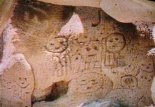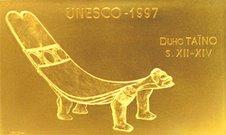Burials excavated at the earliest European settlement in the New World, established by Christopher Columbus in 1493, have surprised archaeologists by including women and children. It had been thought from documentary evidence that the settlers had all been men.
La Isabela, on the north coast of Hispaniola, in what is now the Dominican Republic, was founded by Columbus, pictured below, late in 1493 on his second voyage. The camp at La Navidad, now in Haiti, established on his first voyage in 1492, had been abandoned by the time he got back, and he moved eastwards along the coast of Hispaniola until he found a suitable location for a permanent settlement.
Substantial traces of La Isabela survive, including Columbus's own house and the foundations of a church, all enclosed within a defensive wall. Next to the church, consecrated in January 1494, was a small cemetery in which the casualties of confrontation with the Taino were buried, together with those who had died of famine, diseases and exhaustion.
New excavations in the cemetery by a team of Dominican, Italian and Mexican archaeologists and biological anthropologists have recovered nearly 50 skeletons. What surprised the investigators was that the burials included at least five children of different ages, as well as four women.
One woman was clearly European, while a second seems to have been a Taino, because of her culturally shaped skull, modified by cradle-boarding in childhood. Metabolic diseases, broken teeth and physical stress due to heavy labour were noted in the skeletons, but there was no sign of syphilis or yaws: if any of the settlers had acquired such diseases, they had not yet progressed enough to show in the bones.
There was also no sign of battle wounds, suggesting that relations with the Taino had not produced early casualties.
DNA analyses and isotopic studies of diet are in progress, and the team hopes to find out whether Columbus's crew included Africans: recent studies in Mexico have shown a surprisingly early African presence in early burial grounds in Yucatán.
Author: Norman Hammond
Source: The Times Online
La Isabela, on the north coast of Hispaniola, in what is now the Dominican Republic, was founded by Columbus, pictured below, late in 1493 on his second voyage. The camp at La Navidad, now in Haiti, established on his first voyage in 1492, had been abandoned by the time he got back, and he moved eastwards along the coast of Hispaniola until he found a suitable location for a permanent settlement.
Substantial traces of La Isabela survive, including Columbus's own house and the foundations of a church, all enclosed within a defensive wall. Next to the church, consecrated in January 1494, was a small cemetery in which the casualties of confrontation with the Taino were buried, together with those who had died of famine, diseases and exhaustion.
New excavations in the cemetery by a team of Dominican, Italian and Mexican archaeologists and biological anthropologists have recovered nearly 50 skeletons. What surprised the investigators was that the burials included at least five children of different ages, as well as four women.
One woman was clearly European, while a second seems to have been a Taino, because of her culturally shaped skull, modified by cradle-boarding in childhood. Metabolic diseases, broken teeth and physical stress due to heavy labour were noted in the skeletons, but there was no sign of syphilis or yaws: if any of the settlers had acquired such diseases, they had not yet progressed enough to show in the bones.
There was also no sign of battle wounds, suggesting that relations with the Taino had not produced early casualties.
DNA analyses and isotopic studies of diet are in progress, and the team hopes to find out whether Columbus's crew included Africans: recent studies in Mexico have shown a surprisingly early African presence in early burial grounds in Yucatán.
Author: Norman Hammond
Source: The Times Online









